The Ritz Theatre, located in Scranton, Pennsylvania, was the largest of its kind outside of New York City in the early 1900s. Fittingly, Broadway shows debuted here before heading to the Big Apple. It was also the first theater outside of NYC to feature air conditioning.
Built by Italian immigrant Sylvester Poli in 1907, the Ritz theatre, known then as The Poli, featured seating for 2,000 and was constructed to host the best vaudeville acts in the world. Over history, talents such as Lucille Ball, Harry Houdini, Will Rogers, Buster Keaton and Walter Winchell have graced its stage.
Click the images to see greater detail!
After Poli sold the building in 1925, the grand old theater changed hands multiple times and sustained a massive fire. In 1930s, after being rebuilt, a then- state-of-the-art, 90-ton AC system was installed.
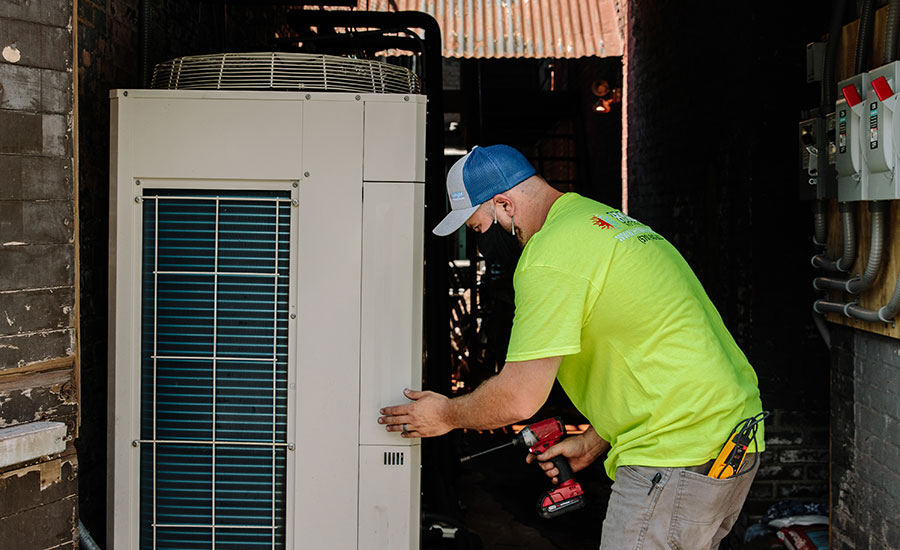
Nick Hynak, partner at Hynak Air Conditioning & Refrigeration, helps commission the VRF systems at The Ritz.
The building’s use diminished over the decades and its upkeep was neglected; a crying shame given that, in its day, The Ritz was a huge economic engine for downtown Scranton. As the years passed, it began looking like a textbook case of urban blight.
It wasn’t until 2001, after being acquired by Scott Schermerhorn, Esq., that things started to improve for the landmark structure at 222 Wyoming Avenue. In 2016, it found vibrant new life and purpose when Schermerhorn began leasing the bulk of the space to The Creative and Performing Arts Academy of Northeast PA (CaPAA).
The academy hosts a variety of performing arts courses and events, and the building provided a world-class atmosphere for such activities, except for the lack of a functional heating and cooling systems in the main theatre.
The long-defunct original system relied on three, four-cylinder compressors. The 30-ton, open-drive compressors were paired with a system of wood and cork ductwork, some of which was large enough to walk through.
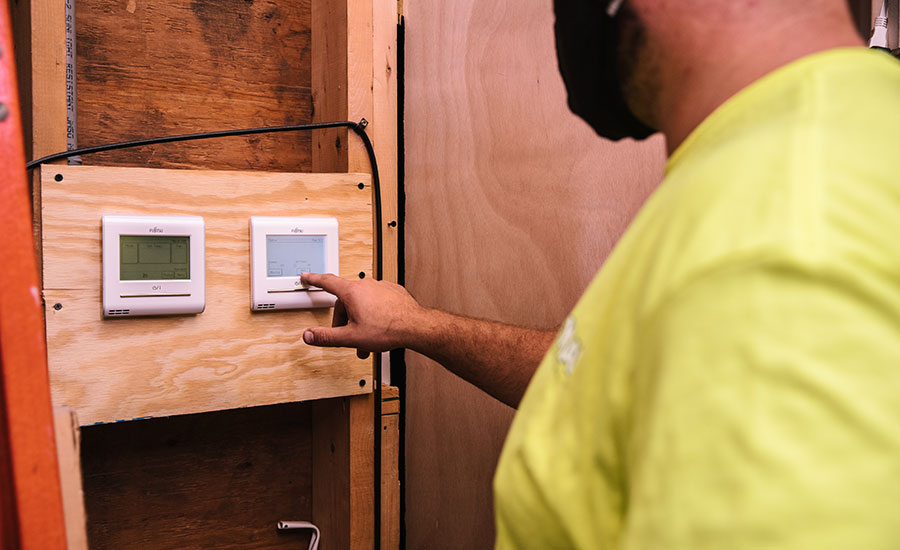
Nick Hynak, partner at Hynak Air Conditioning & Refrigeration, programs VRF controls from inside a storage room behind the theatre stage.

(L-R) Bryce Taylor, technician, and Nick Hynak, partner, arrive at The Ritz.
The Major Improvements Needed to HVAC System
While several small portions of The Ritz are served by modern HVAC systems, the main theatre area still had no heating or cooling in early 2019.
“When we occupied the space, we knew there were two major improvements needed,” says Michael Melcher, CaPAA’s executive producer. “We needed a wheelchair lift, which we installed promptly. Of equal concern was the need for a functional heating and cooling system.”
For several years, CaPAA operated in a mostly-seasonal manner. Classes and events were, for the most part, lumped into the shoulder seasons. Winter conditions inside were so uncomfortable that Melcher avoided an LED lighting retrofit because the existing lights at least provided 30,000 watts of heating as a byproduct. In the summer, loud fans were placed throughout the space, taking the edge off the heat, but also distracting the audience.
“We began looking for a solution in 2017,” says Melcher. “We understood that seeking a grant from the state of Pennsylvania would take considerable time. What we didn’t anticipate was how dramatically a new HVAC system would impact the use of the theatre or our capacity to operate a business here. What transpired has been an absolute game changer.”

The fabric ductwork within the theatre is suspended by cables spanning more than 100 feet across the ceiling.
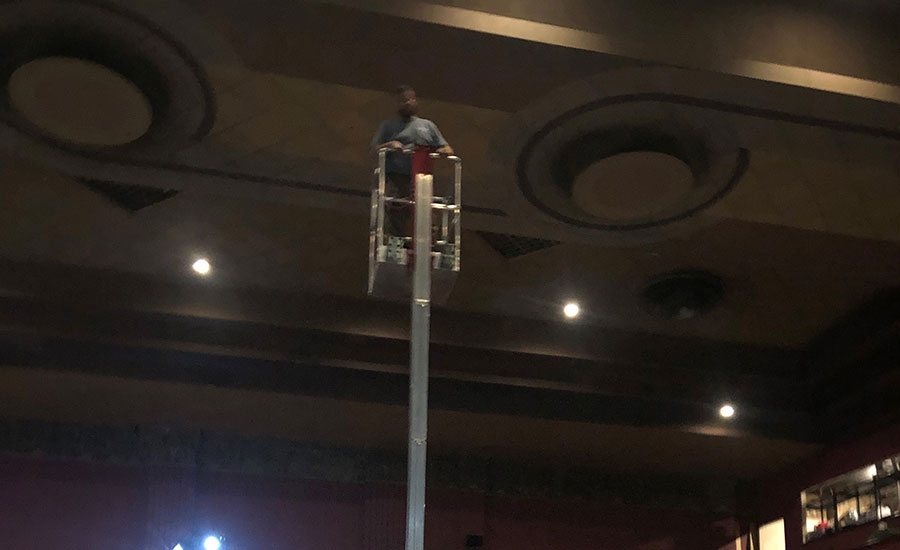
Where ladders couldn’t be used, personnel lifts and scaffolding were used to access the ceiling.
Funding and Bidding for HVAC Contractors
Melcher began to seek bids and funding for the project at roughly the same time. With help from PA senator John Blake and the Lackawanna County Board of Commissioners, a Pennsylvania Community Economic Development grant was issued for $115,000. CaPAA provided an additional $75,000. The grant took nearly three years to come through, not out of the ordinary for this kind of funding.
In that time, Melcher had collected bids from three mechanical contractors. Four more had visited the site and turned the project down because of the challenges it presented.


Where ladders couldn’t be used, personnel lifts and scaffolding were used to access the ceiling.
“I knew that one of the main obstacles for an HVAC contractor was going to be working around the concrete and block construction, with no shortage of three-foot steel girders holding up the theater roof,” says Melcher. “The proposals we got reflected various ways of dealing with those issues.”
Two companies suggested the use of conventional unitary or rooftop unit systems. One of them, whose bid was the lowest by 70 percent, Melcher quickly wrote off as not having enough experience.
The fourth company, Hynak Air Conditioning & Refrigeration, proposed the use of VRF heating and cooling systems. Of key importance was the need for the system to be both responsive and quiet. While not the least expensive proposal by large margin, Hynak’s solution and attention to detail was very impressive to Schermerhorn, Melcher, and his wife, Sheri, who owns CaPAA.

Where ladders couldn’t be used, personnel lifts and scaffolding were used to access the ceiling.
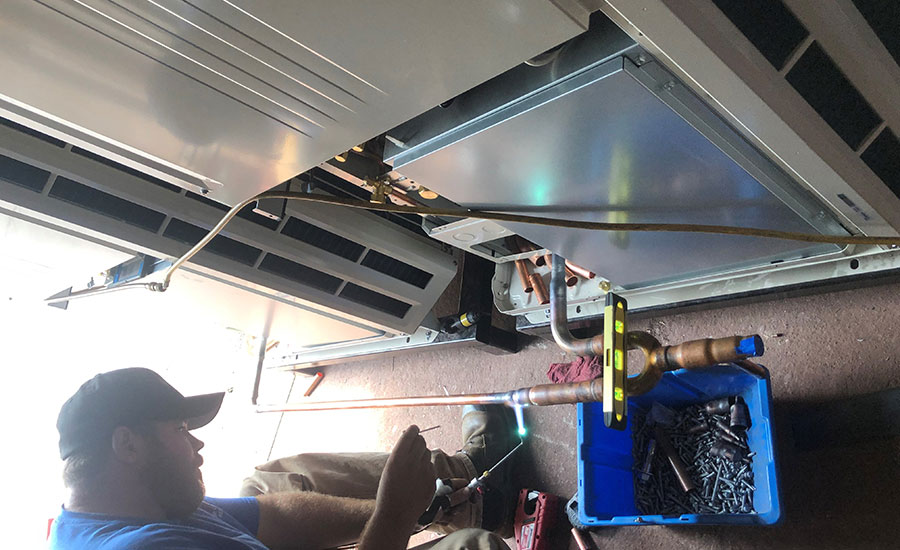
Nick Hynak brazes refrigerant lines during installation.
Design details
“I watched movies at The Ritz when I was a kid,” says John Hynak, owner of the five-person, Scranton-based heating, AC and commercial refrigeration company. “I was referred to Melcher via a previous customer, and we were excited at the opportunity to be involved.”
Hynak recalls a time before the theatre space was reduced. What’s still used for seating today is essentially just the original balcony. The original stage is now below a floor and behind walls. A new stage was built and the seating area was reduced to roughly 425 occupants.
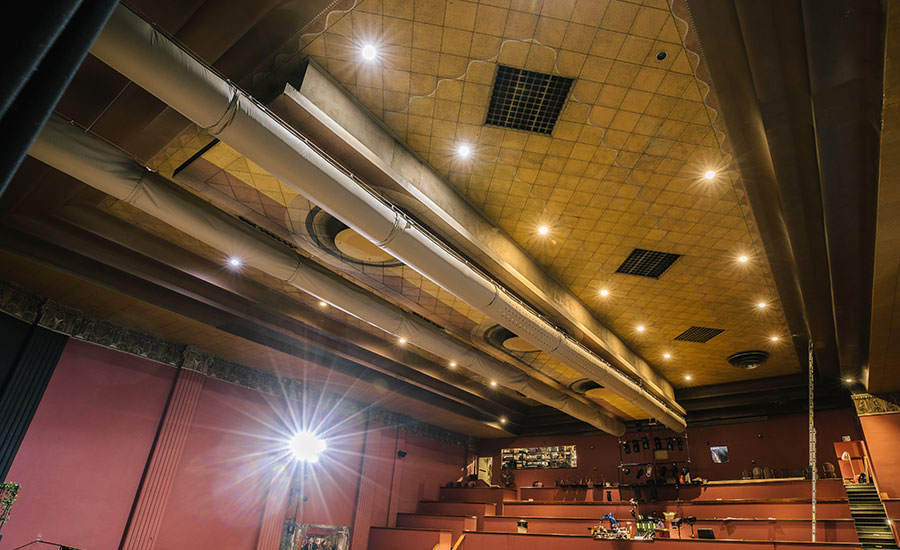

Two, 26-inch diameter fabric ducts supply all conditioned air to the large theatre.
“This isn’t a simple space to condition,” Hynak says. The ceiling is 40 feet above the stage, and we needed to avoid changing the aesthetics to whatever degree possible.”
Hynak’s design concept involved pairing large, high-static VRF air handlers with two fabric ducts that run the length of the theatre ceiling. He looked at air handlers available from several VRF manufacturers and found that Fujitsu’s Airstage V-Series systems were available with air handlers that met his needs, both from the standpoints of static pressure and physical dimension. The air handlers selected are each capable of up to 1.2” W.C. ESP.
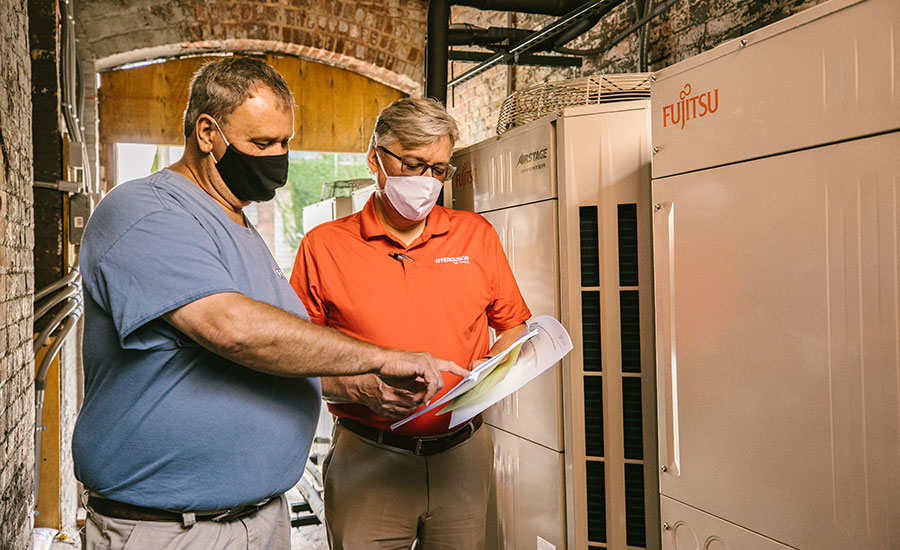

John Hynak and Wayne Warren discuss refrigerant piping after the installation.
“We only use high-end equipment,” explains Hynak. “We’ve installed Fujitsu VRF systems in the past, and have had great experiences with Wayne Warren, at Ferguson Philadelphia VRF division. He is always a great help during system design and start-up.”
Hynak provided the load calculations to Warren; just under 32 tons of cooling are needed to condition the room in the event that 400 people occupy the space on a design day. The heating capacity of the four air handlers combined is 960 MBH. With this info, Warren helped with equipment sizing and selection.
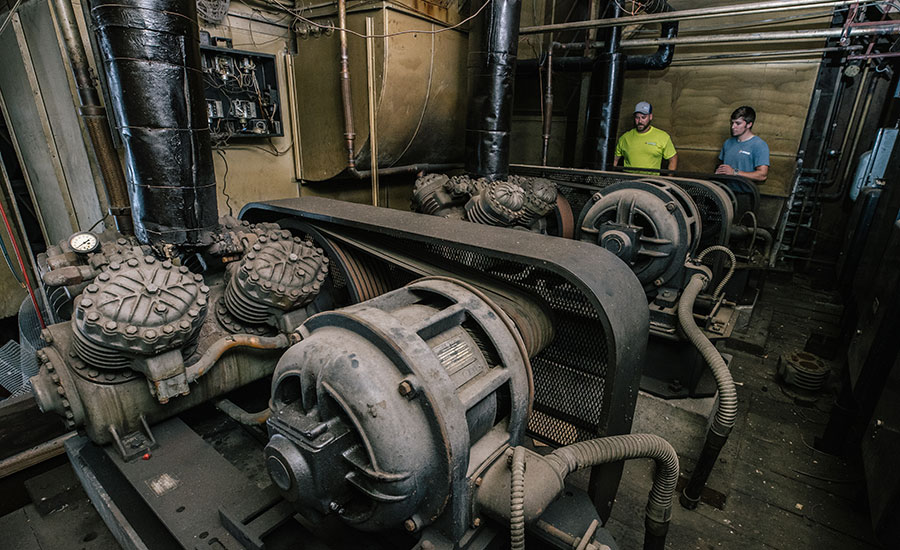
The theatre’s original AC system included three, four-cylinder, open drive compressors at 30-tons each.
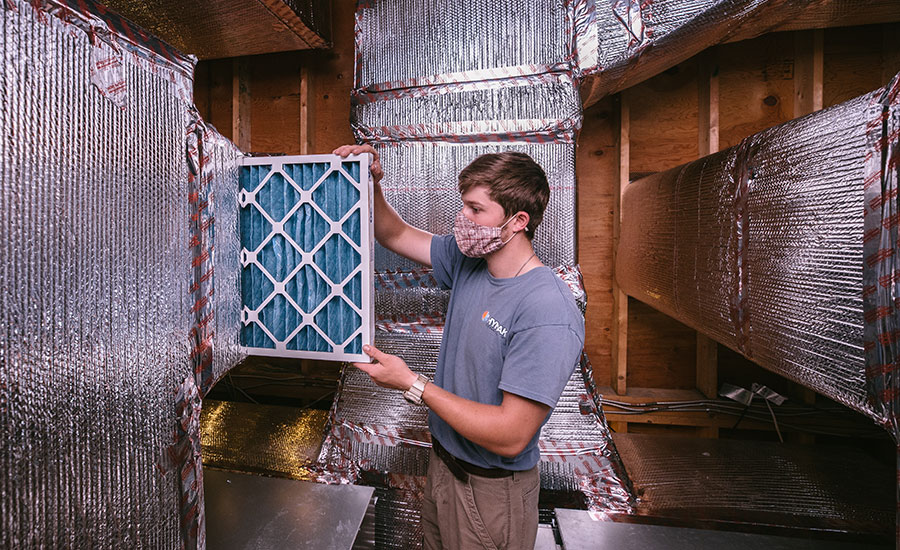
Technician Bryce Taylor installs a filter in a custom plenum.
Four Airstage condensing units were installed in a street-level, outdoor corridor; one 10-ton unit, a six-ton and two eight-ton units. The units were paired into 16-ton systems, with line sets running more than 100 feet to a storage area directly above and behind the stage. Due to the size and weight of the air handlers, they could not be installed within the theatre itself.
In the storage area, the four, eight-ton horizontal air handlers are installed, two per custom plenum. Each plenum, constructed of double-reflective insulation made by Reflectix, is connected to one fabric duct.
“We developed the plan to use the fabric duct, but it was Wayne’s idea to pair the air handlers up to meet our design factors,” says Hynak. “These are the largest air handlers that Fujitsu makes in this configuration. Because they can be paired, we were able to reduce the number of ducts we needed, and dramatically reduce the level of noise that the system emits.”
The ducts are manufactured by Air Distribution Concepts. Each one is 90 feet long and 26-inch in diameter, supplying up to 6,400 CFM per duct.

Four, eight-ton horizontal air handlers were paired together in two custom plenums, each of which supplies air to a single fabric duct in the theatre.
A Careful VRF System Installation
“We were careful to match the color of the duct to the existing ceiling tile,” explains Hynak. “Both designing and installing the system with minimal impact to the historical integrity of the space was a challenge. For example, the Art Deco, plaster-covered concrete arch where the air handlers were installed was disturbed as little as possible.”
Hanging the ducts across the giant span wasn’t easy either. A personnel lift was used where possible, and 38-foot scaffolding was erected everywhere else. Stainless aircraft cable was stretched more than 100 feet across the theatre ceiling. Anchored only at each end and once in the middle of the room, two cables per duct support the entire air distribution system.
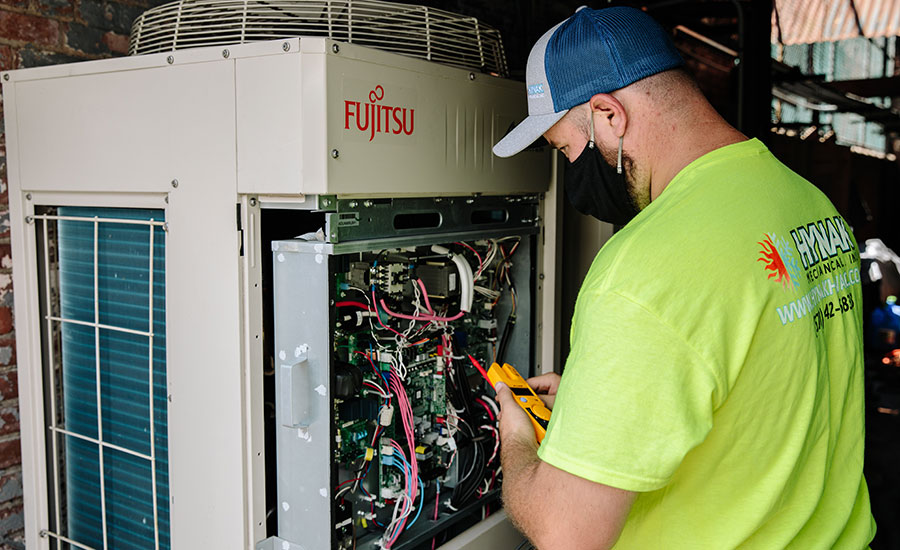
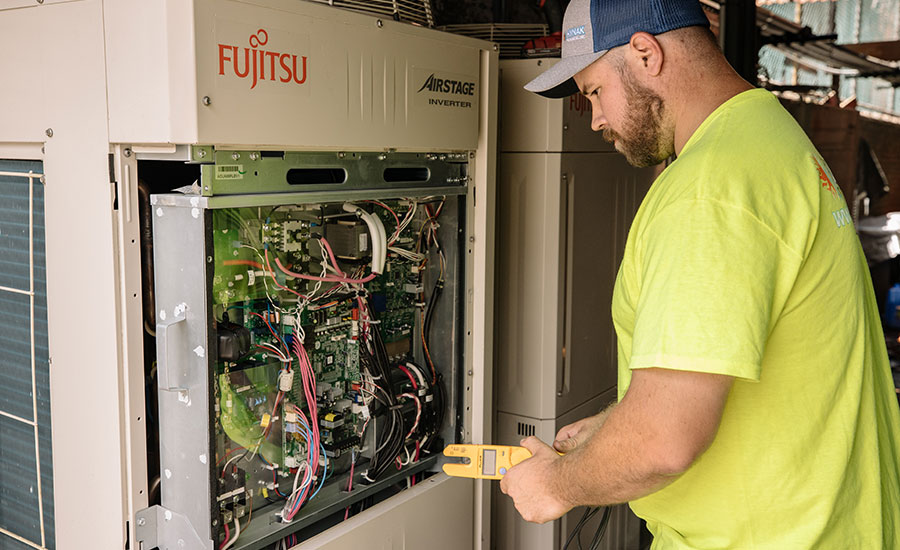
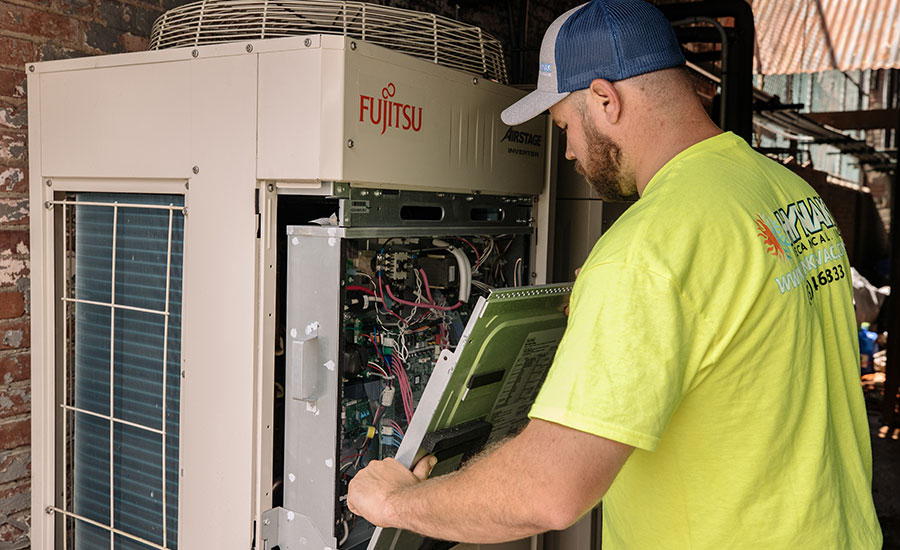
Nick Hynak, partner at Hynak Air Conditioning & Refrigeration, helps commission the VRF systems at The Ritz.
Over the month-long installation process in July of 2019, the Hynak crew worked many nights. The work that included scaffolding, in particular, was conducted quickly. CaPAA still needed the space for dance studio and acting classes.
“We greatly appreciate the fact that the systems are independent, providing us with some level of redundancy,” says Melcher. “If for some reason a system went down, we can still maintain regular operation.”
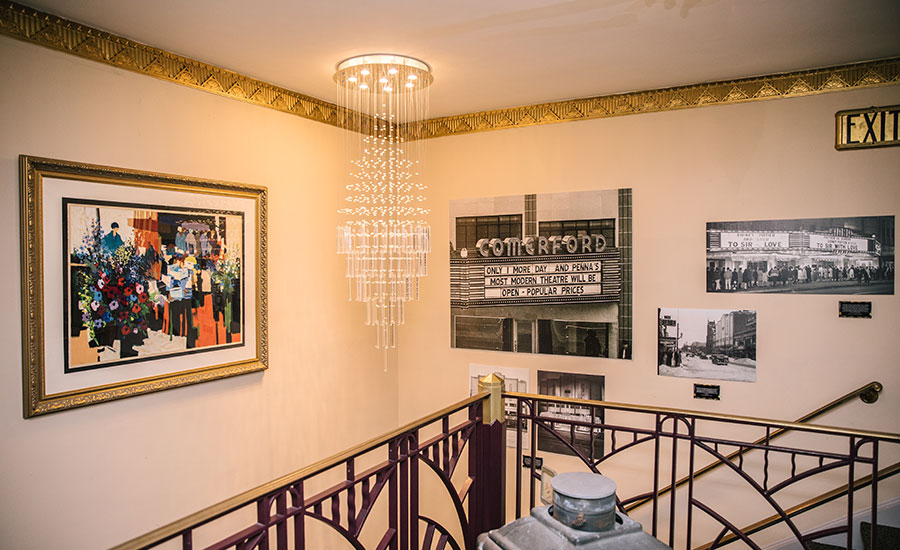
Built in 1907, the Ritz theatre has long been a landmark in downtown Scranton, PA.
Two Year Payback
Commissioning took place in October of 2019, and the system was put into use immediately. Warren and Rob Inderwies, Ferguson VRF technical service advisor, joined Hynak during start-up. The only remaining need was to fabricate two ventilated metal doors to secure the corridor in which the Fujitsu condensing units are installed.
“We’ve been blown away with the performance of the system,” says Melcher. “Within 20 minutes of turning the system on, the space is comfortable. Beyond its performance though, the impact it has had on the business, via the services we can now offer the community, are amazing.”
When CaPAA first occupied the Ritz, they hosted a few small groups of performing arts students. Today, there are three divisions, each with sub-sections. Students from K-12 are accommodated, and there’s even an adult, semi-pro division.
Thanks to the heating and cooling system, a variety of programs and offerings have been added. Weddings are held in the theatre, as are benefit events, stand-up comedy nights, TED Talks, birthdays, private showings, summer camps, etc.
“When we stopped our usual programs due to COVID-19, we learned of parents who needed help with cyber-schooling,” explains Melcher. “So we developed a safety plan and converted the back of the theatre to study labs. We hired tutors and coaches to create a fantastic learning environment, and the only concern we’ve heard is that the study program won’t continue after the pandemic ends. My wife and I are assuring parents that as long as there’s a need for it, we’ll continue.”
Melcher says that because of the added revenue for CaPAA, the system would have paid for itself in two years, but they had no way of knowing that beforehand. The Melchers were expecting monthly energy bills around $1,800, but they haven’t received a single bill over $600, and the system operates every day of the year.
“As a business, I don’t know if we’d have made the smart decision to move forward with the installation without the grant,” Melcher continues. “In retrospect, this is literally the best decision we’ve made, long-term or short-term, for our business. It’s a dream, and in no small thanks to Hynak, Ferguson VRF Division, and Fujitsu’s tech support.”
This new chapter in CaPAA’s history is all about the kids. The Ritz gives them a safe space to explore their passions at a time when the school districts in Scranton are considering removal of the arts from public school curriculum altogether.
The ventilated metal gates protecting the condensing units were the cherry on top for CaPAA. Schermerhorn, the building’s owner, took the initiative to pay the $11,000 cost for the doors.
“The new system is a great asset to the property and has completely changed how the space is used,” he says. “CaPAA has been great for The Ritz, and guarding the system is the least that we could do.”
It appears as though The Ritz is quickly regaining its status as an economic engine in downtown Scranton.









